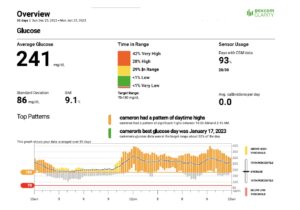
The Patient:
Monica is a 24-year-old woman with a four-year history of type 1 diabetes. She is currently on an Omnipod pump and a Dexcom CGM, but at the time of her blood sugar challenges below, her pump and CGM did not communicate with each other (there was no automatic insulin delivery) like the Tandem Control IQ and Omnipod 5.
Here is a Snapshot of Monica’s 30-day Dexcom Download:

The Problem:
As you can see from Monica’s CGM download, she is not doing very well.
- Her average glucose is 241 mg/dL. Target glucose is less than 155 mg/dL.
- Her estimated A1c is 9.1%. The target for most people is less than 7%.
- Her standard deviation is 86 mg/dL. Standard deviation measures the variability in glucose levels, and the typical goal to shoot for is less than 50 mg/dL.
- Her time in range (defined as the time someone is between the target range of 70 and 180 mg/dL) is only 29%, when the goal is over 70%.
If you’d like to learn more about how to read and understand the numbers on a CGM download, watch the video I did with Dr. Schafer Boeder called Think Like an Endo.
The good news is that Monica is not having too many lows, but that is at the expense of lots of hyperglycemia as her time above range is 70% (high and very high).
Looking at her 24-hour profile, you can see she goes to bed on the high side, at about 250 mg/dL, but she comes down overnight and is very flat with no hypoglycemia between the hours of 2:30 AM – 9:30 AM. This tells me the basal rate on her pump is set correctly, but she just goes to bed too high.
In clinic, she told me that every day at 9:30 AM she goes to Starbucks on her way to work and orders a large Matcha Green Tea Latte, which is high in simple carbohydrates (45g) and it has 320 calories! As a result, her glucose levels shoot up super high, and she basically never recovers during the day. Believe it or not, she didn’t ever think to check the nutritional information on the drink because it seemed like it was harmless since it was “just tea”.
Since Monica’s upper CGM alarm was set at 250 mg/dL, she was not alerted when she went high, so she did not give any correction doses to bring herself down.
The Solution:
Monica and I both decided to make the following changes:
- Lower her upper alarm level to 180 mg/dL so she can give a correction dose to limit her time above 180 mg/dL
- Try to make her own Matcha drink at home using Splenda or Stevia.
- Figure out the carbs for the Starbucks drink when she does go there for it, and take her fast-acting insulin (1 unit for every 10 grams of carbs) at least 20-30 minutes before consuming it.
- Make her correction factor – or insulin sensitivity factor – more aggressive for when she makes a correction. For example, she now takes 1 unit of Humalog for every 40 mg/dL above 100mg/dL, and now she will take 1 unit of Humalog for every 30 mg/dL above 100 mg/dL.
The Takeaway:
Carbs and calories can hide out in unassuming places like beverages, and it’s easy enough to check nutritional information on coffee and tea drinks from retail chains like Starbucks, or from ingredients you can make at home.
Alerts and alarms won’t do you any good if they’re set too high or too low. The purpose of an alert is to notify you so you have time to make adjustments that will help keep you in your target range for a longer period of time. Watch the video Jeremy and I did on how to set your alerts and alarms here.
And remember, don’t be on the See Food Diet…see it and consume it!


Before I was diagnosed with type 1 two years ago I would get that same Matcha Latte from Starbucks blended. It’s super delicious and refreshing. Especially in the summer! Your story has made me sad lol
You can still enjoy it! Just remember to bolus and/or make a copycat at home…life’s too short to not indulge in things you love from time to time!
Starbucks pre sweetens their matcha mix – I asked.
Another depressing fact, the sugar chains in milk are shortened when the milk is steamed, thus making it taste slightly sweeter, and presumably raising the glycemic index. The bump may not be substantial enough to make an unsweetened latte or cap high glycemic but it will raise the index somewhat.